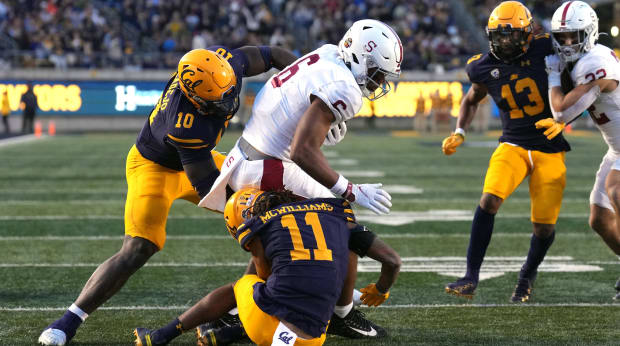Stanford and California’s candidacy for admission to the Atlantic Coast Conference has stalled one vote short, sources familiar with the process tell Sports Illustrated. While league members have stopped short of declaring that the Bay Area schools’ addition to the league is off the table, it doesn’t appear likely that the results will change.
The two members of the disintegrating Pac-12 need 12 of the 15 members of the ACC to support their move. Four schools stood opposed when the issue was discussed Wednesday night, sources say: Florida State, Clemson, North Carolina and North Carolina State. Lacking the requisite numbers, sources say it is unlikely that the potential expansion of the league will be put to a formal vote.
Sources described ACC members Notre Dame, Pittsburgh, Georgia Tech and Louisville as among the most vocal in advocating for the Cardinal and Golden Bears to join the league. ACC commissioner Jim Phillips has been leading the discussion, presenting financial and scheduling scenarios to the league members.
In explaining his advocacy for Cal and Stanford this week, Notre Dame athletic director Jack Swarbrick told ESPN, “The notion that two of the very best academic institutions in the world who also play [Division I] sports could be abandoned in this latest chapter of realignment is an indictment of college athletics.”
The selling points for Stanford and Cal’s admission to the league: elite academics and broad-based sports excellence, both of which fit with the general ACC profile. The drawbacks: distance, the lack of football impact in recent years and thus the lack of an appreciable addition to the league’s per-school revenue.
Barring a change of heart that would give Cal and Stanford the 75% voting threshold, the two schools and fellow Pac-12 members Oregon State and Washington State are evaluating other options. The American Athletic Conference and the Mountain West both would be interested in adding the four schools, or some combination of them. The Mountain West offers geographic continuity, while the AAC has the richer media-rights distributions.

Darren Yamashita/USA TODAY Sports
Or the Pac-12 could attempt to recruit at least four new members, getting back to the minimum of eight schools required for FBS certification. (Under NCAA rules there is a two-year grace period to remain viable for a conference that dips below eight members.) Going independent in football while finding a home for other sports could also be an avenue, though perhaps only for Stanford. Both those options are rife with complications and hurdles.
If the Pac-12 wanted to raid the Mountain West, the exit fee for 2024 ($35 million) looms prohibitively. It also doesn’t help that the league is faced with paying back a $50 million overpayment to Comcast, and it’s unclear how much support Pac-12 commissioner George Kliavkoff has to continue leading that league and plotting its course. There are reports that former NCAA administrator and West Virginia athletic director Oliver Luck has been hired by the league as a consultant. For the moment, the Pac-12 has Autonomy Five stature with the College Football Playoff, though that will be a point of discussion and likely change when the CFP commissioners meet later this month in Dallas and next month in Chicago.
If Stanford is shopping for a new conference for its Olympic sports while attempting football independence, it will be difficult to find one with adequate competition for the premier all-sports athletic department in the nation. The school would need to scrape together a broadcast platform for football without generating much revenue, while also dealing with increased travel costs.
Sources characterized the lack of a grant-of-rights tether with the AAC as a potential selling point for the Pac-12 survivors, though exit fees could come into play. If nothing else, the AAC could be a way station for Cal and Stanford while waiting to see whether the Big Ten reconsiders and expands to 20. The league added Pac-12 members Oregon and Washington last week, moving to 18 schools and opting against the Golden Bears and Cardinal.
The AAC would be able to pitch the Bay Area schools on the academic credentials of some of its members, most notably Rice, Tulane, the Naval Academy and SMU. South Florida is also a recent addition to the prestigious Association of American Universities, of which Stanford and Cal are charter members dating to 1900.
Mountain West Conference commissioner Gloria Nevarez described her league as “in a really good place,” while acknowledging that “all options are on the table” in terms of adding members—and keeping its current members from being poached by a reconstituted Pac-12. Nevarez became the MWC commissioner in January and said her job has been largely consumed with the realignment landscape.
“People ask me, ‘what’s your list?’ Nevarez says. “It’s not a list, it’s a whiteboard. It’s a matrix. The options are never-ending. The job of a modern commissioner is to monitor all these things.”
While the Pac-12 is preparing for a final season as a 12-school entity, the clock is ticking on the leftover four to find homes for 2024. At the moment, they have only half a guaranteed schedule for next football season: three non-conference games and three games against each other—and that number could dwindle if one or more schools finds a different league in the coming weeks.
“There is just a lot of sadness seeing where these schools are right now,” a source with Pac-12 ties says. “It’s hard to believe it’s come to this point, where there are no good options.”







